

I love this and I hate it. I'm not using extremes as a rhetorical device. I really love it with all my heart and I hate it too. It's just one of many examples of how Mexico has forced me to stretch my gut and my psyche to the breaking point.
These are pictures of the way most people here in Alamos start out their adult lives. They work, save money and buy a bag of cement and a few bricks every time they get a chance. Then they build their own house, little by little, without borrowing money. Without rent or a mortgage to pay, without the associated stress, they can then attend to what most Mexicans still think are the important things in life: friendship, family, and enjoyment of the here and now. In 5-10 years, the chances are good that this one room deal will turn into a 5 room palace, and will be plastered and painted outside. All without borrowing a dime. People who make about $150 a week do this routinely. Many even care enough about Alamos that they will eventually add colonial-style cornices and window and door details on this budget.
Some even start out in tar-paper shacks, camping out on their land until they get the first brick room built. They build on from there.
I've watched these new neighborhoods crop up around Alamos for nearly 10 years now. What appears to be a shantytown now will have cute little houses, fruit trees, a soccer field, children dressed in their school uniforms walking to school, and well dressed professionals in just a few years.
It is a testament to the Mexican work ethic, and to the millenia-old human struggle for happiness. While the American refrain was life, liberty and the pursuit of happiness, the Mexican motto was "justice, land, and liberty," because it was understood that there is no life and no pursuit of happiness without land. The Mexican experiment is new. The Constitution was written in 1917 and had much to say about land reform and redistribution. It is still a revolutionary government with a revolutionary constitution. The above lots were bought for about $100 each.
It also just common sense. The people who live in the homes shown above probably have a greater net worth than most US citizens with a $250,000 mortgage.
Mexicans should give lessons on economics around the world. Nobody can stretch a penny better.
I hate what the above pictures portray too. Brick homes are built with concrete corners and bond beams for a variety of reasons. It is a simple method of construction that requires little skill or knowledge, so just about anybody can do it--it is accessible to the masses. You can build slowly over time this way. No worries about adobe melting in the rain. And, in all fairness I should mention, we live close to the San Andreas fault, so concrete reinforcement is strongly recommended.
But as a result of this building method being in use over generations, the builders have lost the skill of their forefathers. Downtown colonial Alamos is an architectural wonder. There are stately old mansions with 3 foot thick adobe walls built higher than any new building in town, but with no cement and no concrete corners. The proportions and the architectural details are exquisite.
Ancient Rome and Chichen Itza were built without cement too. The stuff just isn't necessary. Aside from being ugly and brittle, Portland cement is an environmental nightmare and a conservator's curse.
I'm not to judge which is the the prettier picture. Is it better to have a more egailitarian society in which most everybody lives in concrete boxes, or was life better in colonial times when craftsmanship reigned but wealth was more grossly unequal than it is now? I'm not sure.
I will say, however, that if you compare the above photos with the best of Alamos' colonial architecture, you can't help but notice that craftsmanship in Sonora is but a shadow of its former self.
And in Mexico as a whole, a country that has churches and public buildings as impressive as any nation on Earth, and that boasted perhaps the greatest synthesis of architecture and ornament (in Maya architecture) in human history when Europe was still in the Dark Ages, these concrete boxes are going up everywhere. That is how far the modern world has fallen in terms of aesthetics.
 Above is a photo I took of the same poor church. You can click for a larger view.
Above is a photo I took of the same poor church. You can click for a larger view.



















